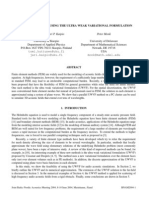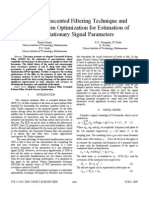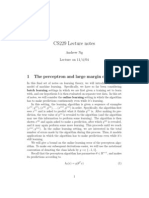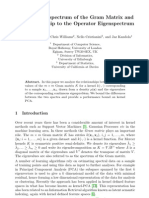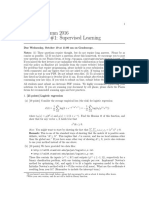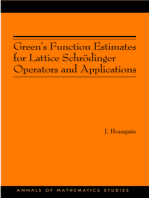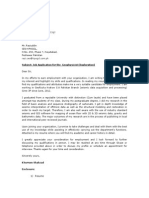Robust Principle Component Analysis (RPCA) For Seismic Data Denoising
Robust Principle Component Analysis (RPCA) For Seismic Data Denoising
Uploaded by
Sourish SarkarCopyright:
Available Formats
Robust Principle Component Analysis (RPCA) For Seismic Data Denoising
Robust Principle Component Analysis (RPCA) For Seismic Data Denoising
Uploaded by
Sourish SarkarOriginal Title
Copyright
Available Formats
Share this document
Did you find this document useful?
Is this content inappropriate?
Copyright:
Available Formats
Robust Principle Component Analysis (RPCA) For Seismic Data Denoising
Robust Principle Component Analysis (RPCA) For Seismic Data Denoising
Uploaded by
Sourish SarkarCopyright:
Available Formats
Robust principle component analysis (RPCA) for seismic
data denoising
Jinkun Cheng, Ke Chen and Mauricio D. Sacchi
Department of Physics, University of Alberta
Summary
Principal component analysis (PCA) is an effective tool for random noise attenuation. It has been
widely used in seismic data processing for the enhancement of the signal-to-noise ratio of seismic
data. However, PCA lacks robustness to outliers and, therefore, its applications to random noise
suppression has limitations. We present a robust PCA (RPCA) method that can be utilized in the
frequency-space domain to eliminate erratic noise. The method adopts a nuclear norm constraint
that exploits the low rank property of the desired data while using an `1 norm constraint to properly
estimate erratic (sparse) noise. The problem is then tackled via the first-order gradient iteration
with two steps of soft-thresholding. We use synthetic examples to illustrate the effectiveness of the
algorithm.
Introduction
Seismic data are always contaminated with noise. Therefore, signal-to-noise ratio enhancement
plays an important role in seismic data processing. A variety of methods that exploit the differences
between signal and noise have been developed. Noise removal techniques based on principal com-
ponent analysis (PCA) are of special interest to this article. Ulrych et al. (1999) illustrated how matrix
rank reduction methods can be utilized to eliminate incoherent noise from seismic records in time
domain. A related family of methods, the Karhunen-Loeve transform, has been introduced for the
enhancement of signal-to-noise ratio (Al-Yahya, 1991) as well. To handle dipping events, Trickett
(2003) proposed the f − x − y eigenimage filtering that applies matrix rank reduction to frequency
slices. Cadzow de-noising (Trickett and Burroughs, 2009), or singular spectrum analysis (SSA) (Sac-
chi, 2009; Oropeza and Sacchi, 2011) also operates in frequency space domain. However, Cadzow
denoising does not operate on the f − x data themselves but on Hankel matrices that are formed from
data in f − x domain.
Although the aforedescribed rank reduction methods are very effective for attenuating the random
Gaussian noise, their application to real data problems can be limited because they lack robustness
to erratic noise. In seismic data processing, erratic noise includes swell noise, power line noise and
artifacts caused by glitches in the recording instrument. Outliers tend to manifest as high-amplitude
isolated signals that do not obey the Gaussian distribution. Therefore, the conventional least squares
error criterion utilized by PCA will perform poorly (Golub and van Loan, 1996; Trickett et al., 2012;
Chen and Sacchi, 2014).
In this article, we present an algorithm named robust PCA (RPCA) to suppress erratic noise and
blending noise in simultaneous sources acquisition. We consider the minimization of a cost function
that combines a weighted nuclear norm and an `1 . The problem is then tackled via the gradient
iteration with two steps of soft-thresholding.
GeoConvention 2015: New Horizons 1
Theory
We consider to apply the proposed algorithm on a 3D seismic volume D(t, x, y). The Fourier transform
can be adopted to map data from t − x − y domain to ω − x − y domain. At a given frequency ω0 ,
the spatial data, D(ω0 − x − y), can be denoted via a matrix D(x, y). We can remove ω0 from the
analysis knowing that the algorithm operates for all frequency slices. As the desired signal is coherent
along two spatial directions, it can be estimated via a low rank matrix X. The observed data can be
expressed via
D = X + E, (1)
where E is a sparse matrix corresponding to the additive erratic noise. The RPCA method suggests
the following problem. Find X such is of low rank and ||E||0 is minimum. Where ||E||0 is the `0 norm
of E means the number of non-zero element in E. The latter is an NP-hard problem. In order to make
the problem tractable, we consider to the `1 norm, which is defined by the summation of absolute
values of the matrix elements, to replace the `0 norm and to use the nuclear norm which is defined
as the summation of singular values of the matrix, to replace the low rank constraint. The `1 norm is
the tightest convex relaxation of the `0 norm and the nuclear norm is the tightest convex relaxation
to the low rank constraint, respectively. We also introduce further relaxation with a Frobenius norm
constraint, ||D − X − E||2F , to tolerate the inclusion of Gaussian noise in the seismic data. The resulting
cost function is as follows
1
min J = ||D − X − E||2F + λ ||E||1 + ||X||∗ , (2)
2µ
where λ is a trade-off parameter that balances the sparsity and low rank constraints. The scalar µ is
a small constant that controls the inclusion of Gaussian noise.
The alternating first-order gradient method is utilized to estimate the low-rank data X as well as the
sparse matrix that represents the erratic noise E. We consider to minimize the cost function via an
iterative scheme. For this purpose we adopt a sub-gradient optimization technique (Zhou et al., 2010)
Xk+1 = min ||X||∗ + ||X − X̂k ||2F
(3)
Ek+1 = min λ ||E||1 + ||E − Êk ||2F ,
where X̂k and Êk are given by the gradient of the separable quadratic system
1
X̂k = Xk − (Xk + Ek − D)
2µ
(4)
1
Êk = Ek − (Xk + Ek − D) .
2µ
The two sub-problems defined by equation (3) are commonly seen in the field of compressive sensing
and matrix completion, respectively. The matrix Ek+1 is typically given by soft-thresholding the entries
of Êk as follows
λµ
Ek+1 (i, j) = max(|Êk (i, j)| − , 0) , (5)
2
where Êk (i, j) denotes the element in matrix Êk . Similarly, Xk+1 can be computed by applying soft-
thresholding to the singular values of X̂k (Fazel, 2002; Recht et al., 2010) as follows
µ
Σ̂(i, i) = max(|Σ(i, i)| − , 0) , (6)
2
where we assume X̂k = UΣV∗ and Xk+1 are then recovered by the new set of singular values Σ̂(i, j).
The resulting algorithm is summarized in Algorithm (1). In each iteration, we modify the current
GeoConvention 2015: New Horizons 2
estimate of the low-rank data and erratic noise in the opposite direction to the gradient of the quadratic
term. Then we apply two steps of soft-thresholding to the modified estimators . The convergence
of this algorithm is very similar to the convergence of the FISTA algorithm utilized for l1 − l2 inverse
problems (Zhou et al., 2010; Beck and Teboulle, 2009).
Algorithm 1 RPCA
Inputs:
Spectral matrix D, trade-off parameter λ and stopping criterion ε
Initialize:
X0 = 0; E0 = 0; k = 1
repeat
1
X̂k = Xk − 2µ (Xk + Ek − D)
1
Êk = Ek − 2µ (Xk + Ek − D)
[U, Σ, V] = svd[X̂k ]
Σ̂(i, i) = max(|Σ(i, i)| − µ2 , 0)
Xk+1 = UΣ̂V∗
Ek+1 (i, j) = max(|Êk (i, j)| − λ2µ , 0)
k = k+1
until kD − Xk − Ek k2F < ε
Examples
To test the effectiveness of the proposed algorithm, we first created a synthetic seismic section with
3D linear events (Figure 1a). We then added random, spike-like noise to mimic blending noise gener-
ated by simultaneous source shooting (Figure 1b). Figure (1c) shows the de-noising result and Figure
(1d) shows the error of the estimator. The proposed method effectively suppressed the incoherent
noise. We improve the the signal-to-noise ratio of data from −1.2 dB to a factor of 11.9 dB.
We also tested the algorithm on one common receiver gather of a synthetic 3D VSP data set. Figure
(2a) shows the centre shot line of one common receiver gather without noise. Figure (2b) shows the
same shot line contaminated with noisy observations. The traces are corrupted with erratic noise (the
amplitude of the erratic noise are about 3 times the maximum amplitude of the reflections). Figure
(2c) shows the resulting de-noised shot line with the proposed method. As a result, both Gaussian
and erratic noise were effectively removed. Through RPCA de-noising, we improve the quality of data
from −8.2 dB to a factor of 12 dB.
Conclusions
We presented an algorithm for suppressing erratic noise via a rank-reduction method. The algorithm
relies on the low rank approximation of the spatial data at a given monochromatic frequency in the
f − x domain domain. A nuclear norm constraint for the data, as well as an l1 norm constraint for
the sparse erratic noise have been utilized to design the cost function of the problem. Through tests
with synthetic examples, we show that the proposed algorithm can be utilized for deblending and for
suppressing the erratic noise.
Acknowledgements
The authors are grateful to the sponsors of Signal Analysis and Imaging Group (SAIG) at the Univer-
sity of Alberta.
GeoConvention 2015: New Horizons 3
(a) (b) (c) (d)
hx (m) hx (m) hx (m) hx (m)
200 200 200 200
0 0 0 0
0.2 0.2 0.2 0.2
0.4 0.4 0.4 0.4
t(s)
t(s)
t(s)
t(s)
0.6 0.6 0.6 0.6
0.8 0.8 0.8 0.8
Figure 1 (a)Synthetic data with linear events in CMPx gather 15. (b) Synthetic data with 3 linear
events contaminated with randon, spike-like noise to mimic the pseudo-deblended CMP gather. (c)
CMPx gather 15 after RPCA de-noising, the SNR has been improved by 11.9 dBs. (d) The estimation
error between section (a) and (c).
(a) Source x position (km) (b) Source x position (km)
8 9 10 8 9 10
0 0
t(s)
t(s)
2 2
(c) Source x position (km) (d) Source x position (km)
8 9 10 8 9 10
0 0
t(s)
t(s)
2 2
Figure 2 (a) Centre shot line of the ideal clean common receiver gather of the 3D VSP data set. (b)
The centre shot line of the common receiver gather cotaminated with erratic noise. (c) The centre
shot line of the common receiver gather after RPCA de-noising. (d) The difference between section
(a) and (c).
GeoConvention 2015: New Horizons 4
References
Al-Yahya, K., 1991, Application of the partial Karhunen-Loéve transform to suppress random noise in seismic sections:
Geophysical Prospecting, 39, 77–93.
Beck, A. and M. Teboulle, 2009, A fast iterative shrinkage-thresholding algorithm for linear inverse problems: SIAM J.
Imaging Sciences, 2, 183–202.
Chen, K. and M. D. Sacchi, 2014, Robust reduced-rank filtering for erratic seismic noise attenuation: Geophysics, 80,
V1–V11.
Fazel, M., 2002, Matrix rank minimization with applications: Master’s thesis, Elec. Eng. Dept, Stanford University.
Golub, G. and C. van Loan, 1996, Matrix computations: London: The Johns Hopkins University Press, third edition edition.
Oropeza, V. and M. Sacchi, 2011, Simultaneous seismic data denoising and reconstruction via multichannel singular
spectrum analysis: Geophysics, 76, V25–V32.
Recht, B., M. Fazel, and P. Parrilo, 2010, Guaranteed minimum-rank solutions of linear matrix equations via nuclear norm
minimization: SIAM Review, 52, 471–501.
Sacchi, M. D., 2009, F-x singular spectrum analysis: CSPG CSEG CWLS Convention, 392–395.
Trickett, S., L. Burroughs, and A. Milton, 2012, Robust rank-reduction filtering for erratic noise: 82nd Annual International
Meeting, SEG, Expanded Abstracts, 1–5.
Trickett, S. R., 2003, F-xy eigenimage noise supression: Geophysics, 68, 751–759.
Trickett, S. R. and L. Burroughs, 2009, Prestack rank-reducing noise suppression: Presented at the SEG Technical Program
Expanded Abstracts.
Ulrych, T. J., M. D. Sacchi, and S. L. M. Freire, 1999, Covariance analysis for seismic signal processing, chapter Eigenimage
processing of seismic sections, 241–274.
Zhou, Z., X. Li, J. Wright, E. Candes, and Y. Ma, 2010, Stable principal component pursuit: Information Theory Proceedings
(ISIT), IEEE International symposium, 1518–1522.
GeoConvention 2015: New Horizons 5
You might also like
- Cadwell Sierra II EMGDocument266 pagesCadwell Sierra II EMGAngelica Maria Rios Orozco100% (1)
- German How To Learn German Fast - Including GrammarDocument161 pagesGerman How To Learn German Fast - Including GrammarCharlieLevitt88% (25)
- Cuoi Ky 4106Document4 pagesCuoi Ky 4106Khoa NguyenNo ratings yet
- Training With Noise Is Equivalent To Tikhonov RegularizationDocument8 pagesTraining With Noise Is Equivalent To Tikhonov RegularizationJavad RahmannezhadNo ratings yet
- 1570373210Document5 pages1570373210Bakht ZamanNo ratings yet
- In Homogeneous 1Document8 pagesIn Homogeneous 1Radu CimpeanuNo ratings yet
- Algorithms For Solving Nonlinear Systems of EquationsDocument28 pagesAlgorithms For Solving Nonlinear Systems of Equationslvjiaze12100% (1)
- Robust Phase Retrieval With Prior Knowledge: Anqi Fu Anqif@stanford - Edu October 26, 2016Document3 pagesRobust Phase Retrieval With Prior Knowledge: Anqi Fu Anqif@stanford - Edu October 26, 2016Techie BitsNo ratings yet
- Least Squares Finite Element Model UpdatingDocument8 pagesLeast Squares Finite Element Model UpdatingMohammad Ahmad GharaibehNo ratings yet
- Symmetry: Extended Convergence Analysis of The Newton-Hermitian and Skew-Hermitian Splitting MethodDocument15 pagesSymmetry: Extended Convergence Analysis of The Newton-Hermitian and Skew-Hermitian Splitting MethodAlberto Magreñán RuizNo ratings yet
- Vyboldin - 2019 - J. - Phys. - Conf. - Ser. - 1384 - 012069 PDFDocument6 pagesVyboldin - 2019 - J. - Phys. - Conf. - Ser. - 1384 - 012069 PDFY.VyboldinNo ratings yet
- Kraus 2012Document21 pagesKraus 2012FlorinNo ratings yet
- An Algorithm To Compute The Transfer Function of A Mechanical SystemDocument6 pagesAn Algorithm To Compute The Transfer Function of A Mechanical SystemquestrwpNo ratings yet
- SoftFRAC Matlab Library For RealizationDocument10 pagesSoftFRAC Matlab Library For RealizationKotadai Le ZKNo ratings yet
- Computing Room Acoustics With CUDA - 3D FDTD Schem PDFDocument4 pagesComputing Room Acoustics With CUDA - 3D FDTD Schem PDFLavkeshKumarNo ratings yet
- Cyi3b YveqbDocument10 pagesCyi3b YveqbMohsin MuhammadNo ratings yet
- The Fokker-Planck EquationDocument12 pagesThe Fokker-Planck EquationslamNo ratings yet
- Maria Kulikov A 2015Document6 pagesMaria Kulikov A 2015RAJNI KUMARINo ratings yet
- Seismic Source Inversion Using Discontinuous Galerkin Methods A Bayesian ApproachDocument16 pagesSeismic Source Inversion Using Discontinuous Galerkin Methods A Bayesian ApproachJuan Pablo Madrigal CianciNo ratings yet
- Power Spectral DensityDocument9 pagesPower Spectral DensitySourav SenNo ratings yet
- Alternating Direction Implicit Osc Scheme For The Two-Dimensional Fractional Evolution Equation With A Weakly Singular KernelDocument23 pagesAlternating Direction Implicit Osc Scheme For The Two-Dimensional Fractional Evolution Equation With A Weakly Singular KernelNo FaceNo ratings yet
- Adaptive Unscented Filtering Technique and Particle Swarm Optimization For Estimation of Non-Stationary Signal ParametersDocument6 pagesAdaptive Unscented Filtering Technique and Particle Swarm Optimization For Estimation of Non-Stationary Signal ParameterssarojxyzNo ratings yet
- 1 s2.0 S0898122100003400 MainDocument14 pages1 s2.0 S0898122100003400 Mainwaciy70505No ratings yet
- PerceptronDocument3 pagesPerceptronapi-3814100No ratings yet
- Processing Seismic Data in The Presence of Residual StaticsDocument5 pagesProcessing Seismic Data in The Presence of Residual StaticsMithunNo ratings yet
- On The Eigenspectrum of The Gram Matrix and Its Relationship To The Operator EigenspectrumDocument18 pagesOn The Eigenspectrum of The Gram Matrix and Its Relationship To The Operator EigenspectrumMartine DumontNo ratings yet
- Barlett MethodDocument15 pagesBarlett Methodking khanNo ratings yet
- Power Load Forecasting Based On Multi-Task Gaussian ProcessDocument6 pagesPower Load Forecasting Based On Multi-Task Gaussian ProcessKhalid AlHashemiNo ratings yet
- Approximation Solution of Fractional Partial Differential EquationsDocument8 pagesApproximation Solution of Fractional Partial Differential EquationsAdel AlmarashiNo ratings yet
- Analysis of Performance and Implementation Complexity of Array Processing in Anti-Jamming GNSS ReceiversDocument6 pagesAnalysis of Performance and Implementation Complexity of Array Processing in Anti-Jamming GNSS ReceiversImpala RemziNo ratings yet
- Remezr2 ArxivDocument30 pagesRemezr2 ArxivFlorinNo ratings yet
- Stability and Convergence of The Wavelet-Galerkin ...Document19 pagesStability and Convergence of The Wavelet-Galerkin ...Luu KhoaNo ratings yet
- 1 s2.0 089812219090271K MainDocument15 pages1 s2.0 089812219090271K Mainsatyakali24No ratings yet
- N×P 2 2 2 HS TDocument5 pagesN×P 2 2 2 HS Thuevonomar05No ratings yet
- Csci567 Hw1 Spring 2016Document9 pagesCsci567 Hw1 Spring 2016mhasanjafryNo ratings yet
- Summation by Parts Operators For Finite Difference Approximations of Second-Derivatives With Variable CoefficientsDocument33 pagesSummation by Parts Operators For Finite Difference Approximations of Second-Derivatives With Variable Coefficientsadsfhire fklwjeNo ratings yet
- C2: Band StructureDocument8 pagesC2: Band StructureMike GarciaNo ratings yet
- On A Strong Form of Propagation of Chaos For McKean-Vlasov EquationsDocument12 pagesOn A Strong Form of Propagation of Chaos For McKean-Vlasov EquationsChen YANNo ratings yet
- 2013-Compressed Sensing and Matrix Completion With Constant Proportion of CorruptionsDocument27 pages2013-Compressed Sensing and Matrix Completion With Constant Proportion of CorruptionsHongqing YuNo ratings yet
- (2012) EngOpt - 2012 - Paper - 0384Document7 pages(2012) EngOpt - 2012 - Paper - 0384Guido MoraesNo ratings yet
- A New Predictor-Corrector Method For Optimal Power FlowDocument5 pagesA New Predictor-Corrector Method For Optimal Power FlowfpttmmNo ratings yet
- Robust Joint Transceiver Power Allocation For Multi-User Downlink MIMO TransmissionsDocument5 pagesRobust Joint Transceiver Power Allocation For Multi-User Downlink MIMO TransmissionsKhoaTomNo ratings yet
- Reconstruction of Seismic Data With Least Squares Inversion Based On Nonuniform Fast Fourier TransformDocument8 pagesReconstruction of Seismic Data With Least Squares Inversion Based On Nonuniform Fast Fourier TransformHumbang PurbaNo ratings yet
- Andersson Djehiche - AMO 2011Document16 pagesAndersson Djehiche - AMO 2011artemischen0606No ratings yet
- Estimating Frequency Moments of Data Streams Using Random Linear CombinationsDocument12 pagesEstimating Frequency Moments of Data Streams Using Random Linear CombinationsAbhishek AnandNo ratings yet
- COHEN - Mixed Finite Elements With Mass-Lumping For The Transient Wave EquationDocument18 pagesCOHEN - Mixed Finite Elements With Mass-Lumping For The Transient Wave EquationAndrés MercadoNo ratings yet
- Matrix-Lifting Semi-Definite Programming For Decoding in Multiple Antenna SystemsDocument15 pagesMatrix-Lifting Semi-Definite Programming For Decoding in Multiple Antenna SystemsCatalin TomaNo ratings yet
- Interpolation Algorithm For Asynchronous ADC-dataDocument6 pagesInterpolation Algorithm For Asynchronous ADC-datasosezzzy3No ratings yet
- 1 s2.0 S0034487720300756 MainDocument8 pages1 s2.0 S0034487720300756 MainFahd ElshemaryNo ratings yet
- Lecture 28: The Spectral GapDocument6 pagesLecture 28: The Spectral Gapsemselvan794694No ratings yet
- New Results in The Calculation of Modulation ProductsDocument16 pagesNew Results in The Calculation of Modulation ProductsRia AlexNo ratings yet
- Power Load Forecasting Based On Multi Task Gaussia - 2014 - IFAC Proceedings VolDocument6 pagesPower Load Forecasting Based On Multi Task Gaussia - 2014 - IFAC Proceedings VolKhalid AlHashemiNo ratings yet
- Reconstruction of A Low-Rank Matrix in The Presence of Gaussian NoiseDocument34 pagesReconstruction of A Low-Rank Matrix in The Presence of Gaussian NoiseVanidevi ManiNo ratings yet
- CS 229, Autumn 2016 Problem Set #1: Supervised Learning: m −y θ x m θ (i) (i)Document8 pagesCS 229, Autumn 2016 Problem Set #1: Supervised Learning: m −y θ x m θ (i) (i)patrickNo ratings yet
- 263 HomeworkDocument153 pages263 HomeworkHimanshu Saikia JNo ratings yet
- CS 229, Spring 2016 Problem Set #1: Supervised Learning: m −y θ x m θ (i) (i)Document8 pagesCS 229, Spring 2016 Problem Set #1: Supervised Learning: m −y θ x m θ (i) (i)Achuthan SekarNo ratings yet
- JMM Volume 7 Issue 2 Pages 199-220Document22 pagesJMM Volume 7 Issue 2 Pages 199-220milahnur sitiNo ratings yet
- Two-Step Algorithms For Linear Inverse Problems With Non-Quadratic RegularizationDocument4 pagesTwo-Step Algorithms For Linear Inverse Problems With Non-Quadratic RegularizationJohny TravoltaNo ratings yet
- Lab 3. Spectral Analysis in Matlab - Part IILab 3. Spectral Analysis in Matlab - Part IIDocument12 pagesLab 3. Spectral Analysis in Matlab - Part IILab 3. Spectral Analysis in Matlab - Part IIvilukNo ratings yet
- Line of Sight Rate Estimation With PFDocument5 pagesLine of Sight Rate Estimation With PFAlpaslan KocaNo ratings yet
- Green's Function Estimates for Lattice Schrödinger Operators and ApplicationsFrom EverandGreen's Function Estimates for Lattice Schrödinger Operators and ApplicationsNo ratings yet
- Student Solutions Manual to Accompany Economic Dynamics in Discrete Time, second editionFrom EverandStudent Solutions Manual to Accompany Economic Dynamics in Discrete Time, second editionRating: 4.5 out of 5 stars4.5/5 (2)
- Generalized Nonconvex Nonsmooth Low-Rank MinimizationDocument8 pagesGeneralized Nonconvex Nonsmooth Low-Rank MinimizationSourish SarkarNo ratings yet
- K-SVD: An Algorithm For Designing Overcomplete Dictionaries For Sparse RepresentationDocument12 pagesK-SVD: An Algorithm For Designing Overcomplete Dictionaries For Sparse RepresentationSourish SarkarNo ratings yet
- Simultaneous Dictionary Learning and Denoising For Seismic DataDocument5 pagesSimultaneous Dictionary Learning and Denoising For Seismic DataSourish SarkarNo ratings yet
- Total Variation-Regularized Weighted Nuclear Norm Minimization For Hyperspectral Image Mixed DenoisingDocument22 pagesTotal Variation-Regularized Weighted Nuclear Norm Minimization For Hyperspectral Image Mixed DenoisingSourish SarkarNo ratings yet
- K-SVD: A Robust Dictionary Learning Algorithm With Simultaneous UpdateDocument5 pagesK-SVD: A Robust Dictionary Learning Algorithm With Simultaneous UpdateSourish SarkarNo ratings yet
- Yu2017 PDFDocument8 pagesYu2017 PDFSourish SarkarNo ratings yet
- C MODEL QUESTIONSDocument17 pagesC MODEL QUESTIONSSourish SarkarNo ratings yet
- Weighted Schatten P-Norm Minimization For Image Denoising and Background SubtractionDocument16 pagesWeighted Schatten P-Norm Minimization For Image Denoising and Background SubtractionSourish SarkarNo ratings yet
- Restoration of Seismic Data Based On Alternating Direction Method and Total Variation TheoryDocument5 pagesRestoration of Seismic Data Based On Alternating Direction Method and Total Variation TheorySourish SarkarNo ratings yet
- C ProgrammingDocument186 pagesC ProgrammingSourish SarkarNo ratings yet
- Tu 04 13 Seismic Data Interpolation and Denoising Using SVD-free Low-Rank Matrix FactorizationDocument5 pagesTu 04 13 Seismic Data Interpolation and Denoising Using SVD-free Low-Rank Matrix FactorizationSourish SarkarNo ratings yet
- Star Instructions PDFDocument2 pagesStar Instructions PDFBahram ZandiNo ratings yet
- Train LawDocument3 pagesTrain Lawelisha1227No ratings yet
- Review Paper On Gearless Power Transmission Offset Parallel Shaft Coupling IJERTV3IS030168Document4 pagesReview Paper On Gearless Power Transmission Offset Parallel Shaft Coupling IJERTV3IS030168Siddhartha JainNo ratings yet
- Aptitude Test For Class 11 02Document3 pagesAptitude Test For Class 11 02Trần HuyNo ratings yet
- Solutions Web PDFDocument24 pagesSolutions Web PDFfehim1No ratings yet
- 15959/kamrup Express Sleeper Class (SL)Document2 pages15959/kamrup Express Sleeper Class (SL)Deepak avinashNo ratings yet
- Hematopoiesis: Makio Ogawa, MD, PHDDocument6 pagesHematopoiesis: Makio Ogawa, MD, PHDVredy LesnarNo ratings yet
- SAPM 16 MarksDocument6 pagesSAPM 16 MarksSridevi DeviNo ratings yet
- 3D Building With PhotogrametryDocument32 pages3D Building With PhotogrametryMMM AAANo ratings yet
- Installation Visual C++ and MASMDocument5 pagesInstallation Visual C++ and MASMHugo ValenciaNo ratings yet
- Cytokines: C:/CD DATA/all Collection notes/IMMUNOLOGY/cytokines - Doc - 1Document6 pagesCytokines: C:/CD DATA/all Collection notes/IMMUNOLOGY/cytokines - Doc - 1vishal patelNo ratings yet
- Jennifer Letter 1Document1 pageJennifer Letter 1api-316030498No ratings yet
- Installation Guide Nshield Edge 12.71Document34 pagesInstallation Guide Nshield Edge 12.71rafnasNo ratings yet
- Ficha Shinji (Pathfinder)Document4 pagesFicha Shinji (Pathfinder)José AvajNo ratings yet
- Case Study Alma BH Enterprise Latest Ent530Document27 pagesCase Study Alma BH Enterprise Latest Ent530Erni Rizal100% (1)
- Agricultural Sciences P1 May-June 2023 EngDocument15 pagesAgricultural Sciences P1 May-June 2023 Engnomvelisoowethu21No ratings yet
- Using Compost Tea in Hydroponics - Garden Culture MagazineDocument18 pagesUsing Compost Tea in Hydroponics - Garden Culture MagazineakshayNo ratings yet
- Phy Mock p1BDocument22 pagesPhy Mock p1BA PersonNo ratings yet
- CP19BBA Investment BankingDocument17 pagesCP19BBA Investment BankingGreig KurniawanNo ratings yet
- Unit 1 - Email Addresses - LearnEnglishDocument12 pagesUnit 1 - Email Addresses - LearnEnglishRobert Delgado MontesinosNo ratings yet
- CV and Coverletter PHDDocument4 pagesCV and Coverletter PHDKhurram Shahzad QureshiNo ratings yet
- Cold Water Glass 41Document14 pagesCold Water Glass 41Dimitrios GerogiorgisNo ratings yet
- Ohmtech A/S: Visual Vessel DesignDocument23 pagesOhmtech A/S: Visual Vessel Designwindsurferke007No ratings yet
- Standout Mixes ChecklistDocument3 pagesStandout Mixes ChecklistAndy ferrisNo ratings yet
- Apj Abdul Kalam Technological University Thiruvananthapuram, Kerala, INDIADocument7 pagesApj Abdul Kalam Technological University Thiruvananthapuram, Kerala, INDIArahilNo ratings yet
- Vendor RatingDocument6 pagesVendor RatingTulasi sharmaNo ratings yet
- University of Zakho Mechanical Engineering Department 2 Year 2019-2020 Mechanical Lab/ ThermodynamicsDocument3 pagesUniversity of Zakho Mechanical Engineering Department 2 Year 2019-2020 Mechanical Lab/ ThermodynamicsNorvinyeLorlortorYekoNo ratings yet





